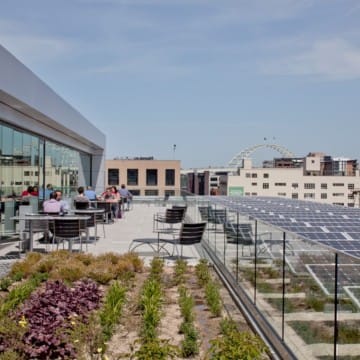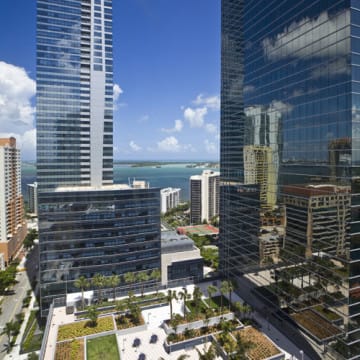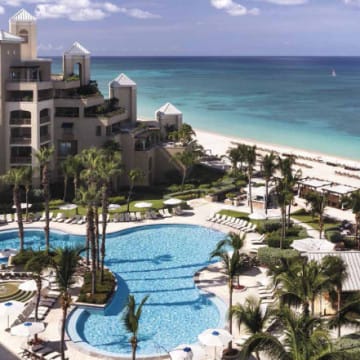Market at Colonnade
An infill retail project developed by Regency Centers, the Market at Colonnade uses water management and reuse technologies on a largely impervious site in North Carolina’s Research Triangle area. The development’s innovative stormwater management approach was a key part of achieving a rezoning for commercial development and became part of the project’s branding, as tenant Whole Foods Market embraced an above-ground cistern.
Context
The Colonnade site is located adjacent to the Falls Lake watershed, which is largely restricted from commercial development. The site required rezoning from office and institutional to commercial use, and stormwater runoff and water quality were key concerns for community members. “What led us down this path was the zoning and the desire for community support and support from the elected officials,” explains Chris Widmayer, vice president of investments for Regency Centers. The small site also did not have space to accommodate a traditional stormwater management device such as a surface stormwater pond or wetland and still achieve the development objectives.
The engineering solution was a rain chain, linking a number of stormwater management practices to capture, detain, treat, infiltrate, and reuse stormwater. The approach reduced runoff from the predevelopment condition by roughly 98 percent. “The holy grail of stormwater is that a drop of rain infiltrates the ground generally where it falls . . . and recharges the aquifer there. That was the ultimate goal,” explains Widmayer. The team sought to capture all runoff from a one-inch rain event and infiltrate it into the underlying soils and detain runoff from both two-year and ten-year design storms. By infiltrating the “firstflush” runoff, the stormwater system exceeds water quality requirements. The system was also designed to reuse harvested rooftop rainwater for both landscape irrigation and indoor use in the toilet system.
“This shopping center has less stormwater runoff than my house—and, actually, a lot less. Almost all of it gets captured by the system on site. Not only do you have the volume captured, but also the associated pollutants that have a negative impact on our drinking water.” Chris Widmayer, Vice President of Investments, Regency Centers
Regency Centers used a North Carolina Clean Water Management Trust Fund grant for the project’s green infrastructure features. This grant contributed toward the cost of the stormwater components of the project, which totaled roughly $727,000.
Innovative Water Management Features
- Cisterns. Three rainwater-harvesting cisterns—one above ground and two subsurface—can collect up to 43,000 gallons of stormwater runoff. Water from the above-ground cistern is reused within Whole Foods Market for toilet flushing, while water from the below-ground cisterns is used for landscaping.
- Subsurface infiltration system. The subsurface infiltration system includes 2,500 linear feet of gravel and pipe trench, typically four feet wide and 3.5 feet deep. The system allows approximately 15,000 cubic feet of temporary storage, permitting infiltration into the underlying sandy loam soils.
- Bioswales and bioretention space. A 250-square-foot grass-lined bioretention area and 450 feet of bioswale capture and treat runoff from the shopping center’s parking lot and further promote infiltration.
- Landscape irrigation system. The landscape irrigation system uses harvested water from the underground cisterns to irrigate turf and landscaped areas on the site, as well as provides for
additional infiltration and groundwater recharge within the remaining wooded area on site. - Underground detention chamber. An additional 350,000 gallons of rainwater can be temporarily stored in the 48,100-cubic-foot underground detention chamber.
Value Proposition
Although proud of the environmental accomplishments of the site, the development team also describes its investment in stormwater technology as a savvy means of achieving the land’s highest and best use. Mark Peternell, Regency Centers vice president for sustainability, explains that “by avoiding the need for an above-ground pond, we had the buildable space we needed to construct a profitable retail center.” Widmayer also emphasizes that the approach works “to enhance development rights and provide density with much cleaner outcomes and cleaner water.”
The Regency Centers team credits its environmental consultants for developing a sophisticated and innovative response to the needs of the constrained site. The team has since received detailed information on how the stormwater management mechanisms have functioned from North Carolina State University researchers, who monitored the site 12 months after its installation and compared its performance to that of sites with similar development conditions. The researchers found that the system took in approximately 130 percent more stormwater than a traditional system, with less than 5 percent of water flowing out, compared to a traditional system. Monitoring results indicated that in the first year a total of 30.6 inches of rainfall was measured on the site, of which only 0.6 inches was released from the site, the difference being infiltrated or reused on site.
Lessons Learned
- Visible green infrastructure can be a marketing boon for a sustainability-minded tenant. Whole Foods chose to feature the above-ground cistern next to its entrance . The cistern became a memorable symbol of the retailer’s values and commitment to sustainability.
- Stormwater can be harvested and managed even on highly impervious sites. Although the site was 80 percent impervious after development, the stormwater management system captures the one-inch rainfall without discharge and can detain up to a ten-year design storm. Researchers from North Carolina State found that the site greatly outperforms nearby sites with higher percentages of permeable surface.
- Green infrastructure can save space and free up developable land, particularly in comparison to a retention pond alternative. Green infrastructure made retail development feasible on this 6.25-acre site, which could not have accommodated a traditional wet detention pond, the retail facilities, and parking.
- Water management mechanisms can be an effective part of a real estate project’s community engagement strategy, particularly in environmentally sensitive areas. The need for rezoning initially inspired the development team to take an innovative approach to stormwater management. Using stormwater technologies allowed the site to meet environmental requirements and achieve support from the surrounding community.


